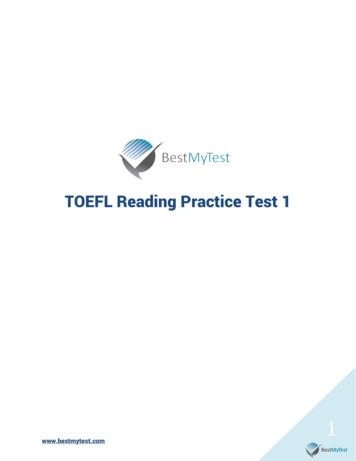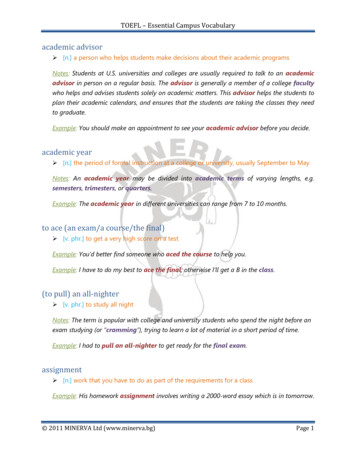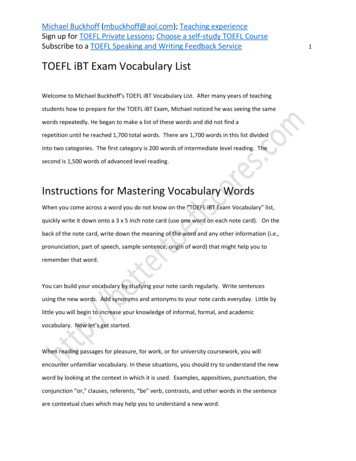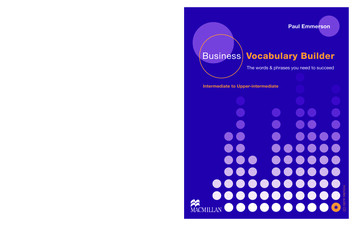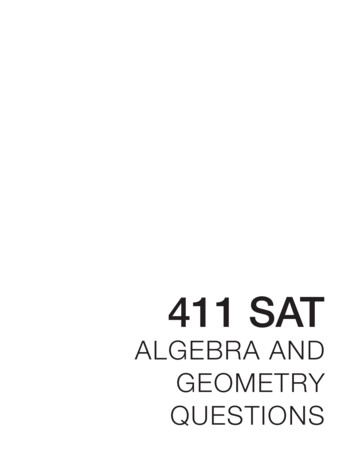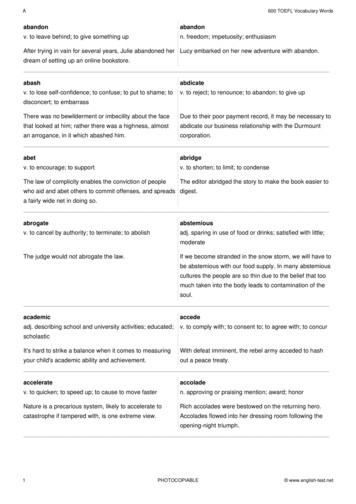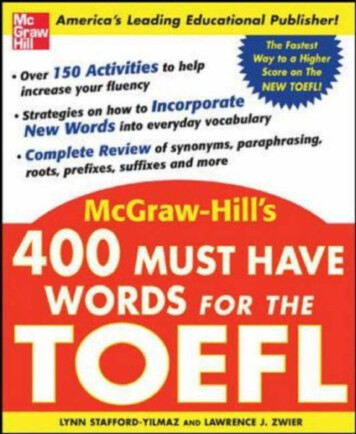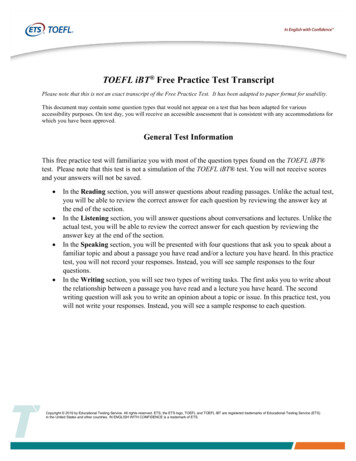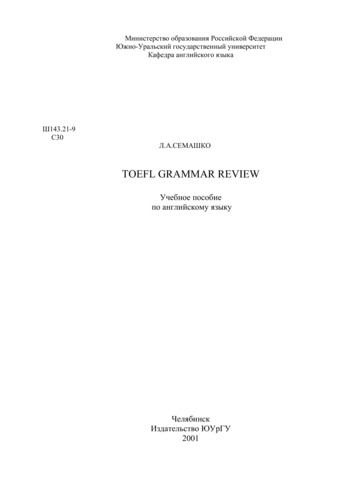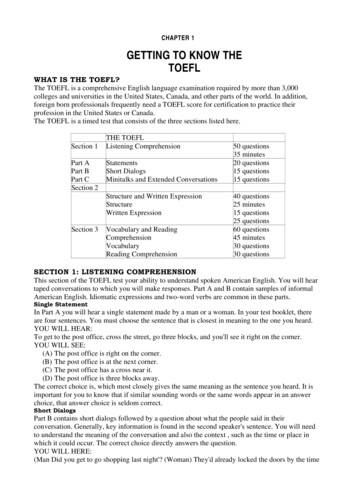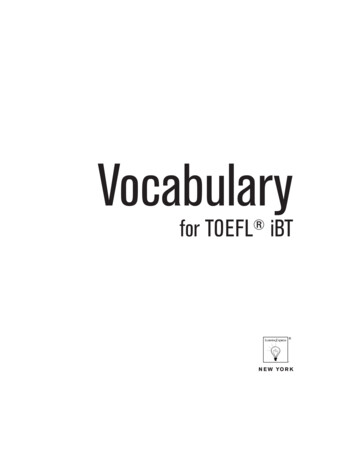
Transcription
6044 Vocabulary ToefliBT(4).qxd 9/19/07 11:44 AM Page iVocabularyfor TOEFL iBT N E W YO R K
6044 Vocabulary ToefliBT(4).qxd 9/19/07 11:44 AM Page iiCopyright 2007 LearningExpress, LLC.All rights reserved under International and Pan-American Copyright Conventions. Published in the United States by LearningExpress, LLC, New York.Library of Congress Cataloging-in-Publication Data:Vocabulary for TOEFL iBT.p. cm.ISBN: 978-1-57685-632-11. Test of English as a Foreign Language—Study guides. 2. English language—Examinations—Study guides. 3. Vocabulary—Examinations—Study guides. 4.English language—Ability testing. I. LearningExpress (Organization)PE1128.V63 2007428.0076—dc222007026015Printed in the United States of America9 8 7 6 5 4 3 2 1ISBN: 978-1-57685-632-1For information on LearningExpress, other LearningExpress products, or bulk sales,please write to us at:LearningExpress2 Rector Street26th FloorNew York, NY 10006Or visit us at:www.learnatest.com
6044 Vocabulary ToefliBT(4).qxd 9/19/07 11:44 AM Page iiiCONTENTSIntroductionv1About TOEFL iBT12Vocabulary in Context123Using Prefixes and Suffixes314Word Roots455Commonly Confused Words—Homonyms616Idioms and Vocabulary Variations74Practice Test 181Practice Test 299Appendix A: Word List117Appendix B: Prefixes, Suffixes, and Word Roots174iii
6044 Vocabulary ToefliBT(4).qxd 9/19/07 11:44 AM Page iv
6044 Vocabulary ToefliBT(4).qxd 9/19/07 11:44 AM Page vIntroductionEveryone has three vocabularies in every language he or she speaks: areading vocabulary, a listening vocabulary, and a speaking vocabulary.You’ve read words you have never heard, and heard words you’ve never read. Yourspeaking vocabulary may ignore many words you have either read or heard but donot use. As you explore the vocabulary in this book, think about bringing these threelarge sets of words together into a rich and useful database that will serve you well.Discovering words you don’t know may send your anxiety level soaring, andnobody does their best work when they’re anxious. With practice, though, you canlearn to take unknown words in stride. Here’s how to start.1. Start small. Don’t tackle the whole sentence at once. There are several techniques for breaking sentences into smaller units. One way you can do thisis to find a verb (an action word that tells you what’s happening) and gradually incorporate the words around it into an increasingly longer phrase asyou decipher its meaning. The verb provides an anchor for the meaningbecause it tells you what is being done.You can also use trial and error to find islands of meaning in a sentence.Find a word or a phrase you understand and start adding a word or two oneither side. As you discover several such islands and gradually enlarge eachone, you will eventually see how they fit together; and then you will understand the dynamics of the whole sentence.2. If the vocabulary in a sentence is a problem, look at the words around it.Usually you can figure out what function a word is serving in the sentence.Ask yourself if it’s an action word. If so, it’s a verb. Is it describing something? Then it’s an adjective or adverb. Is it the subject—the person, placeor thing performing the action in the sentence? It’s a noun or pronoun.Use the surrounding context to help you guess the meaning or at least thepart of speech of an unfamiliar word.3. As you are reading a sentence with blanks or with words you don’t know, itcan ease your anxiety to substitute words or sounds of your choosing inplace of the unknown words. The words something and whatever work wellv
6044 Vocabulary ToefliBT(4).qxd 9/19/07 11:44 AM Page viviVO CA B U LA RY F O R TO E F L iBTin many situations. You may find you prefer nonsense words instead. As themeaning of the sentence gradually becomes clear, you can start substituting words that might work in the sentence.Obtaining a better vocabulary doesn’t have to be hard work. It mostly takescuriosity. Remember those unfamiliar words you encounter in conversations orwhile reading. Take them apart. Welcome them to your world. Share them withyour coworkers, friends, or family. You’ll be greatly rewarded for your efforts—because long after you have finished this book and taken the TOEFL iBT, you’llstill possess a wealthy vocabulary of English words!HOW TO USE THIS BOOKIf you are trying to gain admission into universities where instruction is in Englishand this is not your native language, you will have to pass the TOEFL iBT (Testof English as a Foreign Language Internet-based test). The reason for this is simple: Academic institutions want to be sure that you can read, write, and comprehendspoken English so that you can succeed in the college classroom. Sometimes, thistest will also be used to evaluate you by many government, licensing, and certification agencies, or exchange and scholarship programs.Vocabulary for TOEFL iBT will help nonnative speakers build or renew vitalvocabulary skills. Vocabulary is a broad topic, and it forms the foundation for reading comprehension, grammar, and spelling. For the TOEFL iBT, you will not beallowed to use a dictionary, thesaurus, or other reference tool to help you with unfamiliar words. In general, the better your basic vocabulary skills are, the better youwill do on the entire TOEFL iBT.Whether your exam is months away or coming up in a few weeks, this bookwill help you prepare. Begin getting ready for the TOEFL iBT by creating astudy plan for yourself. Determine how much time you have until the test day,and then decide how much time you can devote to studying each week. WithVocabulary for TOEFL iBT, we suggest that you choose a time each day to improveyour vocabulary. Think about when would be the best time for you. It may befirst thing in the morning, during your commute to work, or before you go tobed at night. Whenever the time is right, just make sure you do it regularly—atleast five days a week for a month. Once you establish a study plan for yourself,you should stick as closely as you can to your plan. Always keep your end goalin mind. If you study hard the first time, chances are you will not have to takethis exam again—ever!
6044 Vocabulary ToefliBT(4).qxd 9/19/07 11:44 AM Page viiI NTR O D U CTI O NNow, once you have set a study plan for yourself, look at the table of contents tosee the types of vocabulary topics covered in this book. You may want to tackle thechapters in sequence, or you may decide to study the sections that give you the mostdifficulty early on in your test preparation.Each chapter is filled with practice questions to test the new skill you just readabout. As you work through the practice questions, you may want to have a dictionary or thesaurus handy. This can help expand your bank of vocabulary words.After you answer the practice questions, you will undoubtedly want to check youranswers against the answer explanation section at the end of each chapter.Vocabulary for TOEFL iBT contains two practice tests at the end of the book.These tests will give you the chance to measure what you have learned and reviewany problem areas that you find. If after answering all the questions you feel like youneed more practice, reread the questions and try responding one more time. Repetition is often the key to success and studies show that most repetitive tasks becomepart of a person’s inventory of skills over time.The book finishes with a helpful word list of more than 650 commonly testedvocabulary words (Appendix A). It will be very beneficial for you to add thesewords to your current vocabulary. We advise tackling the words on the list as youmove through Vocabulary for TOEFL iBT, not waiting until the end of the book.Another helpful list—entitled Prefixes, Suffixes, and Word Roots—is included inAppendix B. Understanding the parts that make up a word can give you a clueabout a word’s definition, and this can help you make educated guesses when taking the TOEFL iBT.vii
6044 Vocabulary ToefliBT(4).qxd 9/19/07 11:44 AM Page viii
6044 Vocabulary ToefliBT(4).qxd 9/19/07 11:44 AM Page 1About TOEFL iBT1The Test of English as a Foreign Language (TOEFL) is used to measureyour ability to use English in an academic setting. The TOEFL is designedto indicate your ability to communicate by measuring the impact of reading, listening, speaking, and writing on effective communication. Strong ability in each ofthese four areas will be necessary as you continue learning in English.WHO SHOULD TAKE THE TESTProficiency in English is essential if you are to follow class discussions and completethe reading and writing assignments in most college classes. In many courses, youmay also be required to deliver oral presentations. And if you are applying to a graduate program, you may be given a position as a teaching assistant, which means youwill be expected to help undergraduate students with their schoolwork, instructthem, and grade their assignments. In order to ensure that you can succeed eventhough you are not studying in your native language, and that you will be a competent teaching assistant if you are applying to graduate school, colleges and otherinstitutions may require you to take the TOEFL. To determine if you need to takethe TOEFL, you should contact each institution to which you are applying foradmission.1
6044 Vocabulary ToefliBT(4).qxd 9/19/07 11:44 AM Page 22VO CA B U LA RY F O R TO E F L iBTOVERVIEW OF THE TESTThe entire TOEFL iBT will take approximately four hours to complete and all testsections will be completed in one day. The test is not computer-adaptive. In otherwords, each test taker receives the same range of questions. The test is worth a totalof 120 points.The first test section is Reading, followed by Listening, Speaking, and Writing.There will be a ten-minute break after the Listening section. After completing asection of the test, you will not be able to return to that section to finish or changeyour answers.READING SECTION(approximately 60–100 minutes) 30 total pointsThis section contains 3–5 reading passages, each followed by 12–14 questions.Question TypesLanguageSkills UsedTopicsSource forResponseFactual informationReadingIdentify informationReadingfrom textpassage 3–6 per set 4 answer choices each worth 1 point eachIdentify informationReading 2 per set at mostin the text that ispassage 4 answer choices eachnot trueNegative factual informationReading worth 1 point eachIdentify informationReading 2 per set at mostthat is stronglypassage 4 answer choices eachsuggested but worth 1 point eachnot statedInferenceRhetorical purposeReadingReading 2 per set at mostIdentify why authorReadingmakes a statementpassageIdentify the meaningReadingof a word in the textpassage 4 answer choices each worth 1 point eachVocabulary 3–5 per set 4 answer choices each worth 1 point eachReading
6044 Vocabulary ToefliBT(4).qxd 9/19/07 11:44 AM Page 33AB O UT TO E F L iBTQuestion TypesLanguageSkills UsedTopicsSource forResponseReferenceReadingIdentify theReading 2 per set at mostgrammatical relationshippassage 4 answer choices eachbetween two words worth 1 point eachin the textIdentify the choiceReading 1 per set at mostthat restates thepassage 4 answer choices eachsentence indicatedSentence simplificationReading worth 1 point eachInsert a sentence inReading 1 per set at mostthe most appropriatepassage 4 answer choices eachplace in a passageInsert textReading worth 1 point eachChoose the threeReading 1 per set at mostmost important ideaspassage 6 answer choices eachin the passageProse summaryReading worth 2 points eachComplete a tableReading 1 per set at mostorganizing thepassage multiple answer choicesmain ideasFill in a tableReading worth 3–4 points eachAs you begin the Reading section of the TOEFL iBT, a passage will appear onthe computer screen. A scrollbar on the right side of the screen will allow you tomove to the end of a passage.At the top of the computer screen is a navigational toolbar. (You should note thatyour time does not stop when you are using the toolbar feature.) The heading onthe left of the toolbar will state the section of the test on which you are working:Reading. The center of the toolbar will state the question you are working on aswell as the number of questions in the section. On the right will be a clock, indicating your remaining time. You may choose to hide the clock by clicking the HideTime button located next to the clock. Above the clock function are six navigationbuttons. Clicking on the View Text button will let you view the entire passage whenanswering questions. The Review button will allow you to review the questions thatyou have answered and make changes. You can adjust the volume by clicking theVolume button. A Help button will provide some additional assistance for you.
6044 Vocabulary ToefliBT(4).qxd 9/19/07 11:44 AM Page 44VO CA B U LA RY F O R TO E F L iBTFinally, there are Back and Next buttons, which allow you to move back and forthbetween questions.LISTENING SECTION(approximately 60–90 minutes) 30 total pointsStimulusLanguageSkills UsedTopicsSource forResponse4–6 lectures, each followed byListeningArts, life sciences,Details fromphysical sciences,lecture6 questionsand social science2–3 conversations, each followedListeningby 5 questionsNonacademic situationDetails fromon campusconversationFor the Listening section of the TOEFL iBT, you will listen to the lectures andconversations through a headset. An image depicting the lecture or conversationwill appear on the screen. This picture is designed to help you imagine the situation. Difficult words or phrases in the passage may be defined for you. When thelistening passage is complete, a question will appear on the screen.A toolbar will appear at the top of the screen. The heading on the left of the toolbar will state the section of the test on which you are working: Listening. Like thetoolbar for the Reading section, the Listening section toolbar will state which question you are working o
Vocabulary for TOEFL iBT, we suggest that you choose a time each day to improve your vocabulary. Think about when would be the best time for you. It may be first thing in the morning, during your commute to work, or before you go to bed at night. Whenever the time is right, just make sure you do it regularly—at least five days a week for a month. Once you establish a study plan for yourself .
